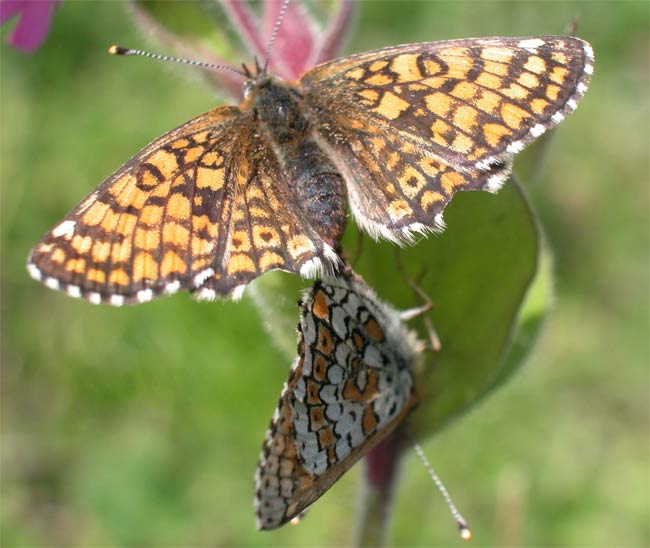Mobility Key to Animals Surviving Human Sprawl

VIRGINIA BEACH, VA—Running away from home can be a rewarding survival technique for female Glanville fritillary butterflies.
New research shows the more venturesome females are stronger fliers and can reproduce more quickly than their less mobile sisters, allowing them to establish new colonies.
The finding, presented here this week at a meeting of the American Physiological Society, could help scientists understand how other species might respond to habitat destruction. The animals best able to migrate are more likely to survive and reproduce, the thinking goes.
"We may be selecting for genes that enhance the dispersal or migratory capability of animals when we fragment the landscape," said Howard Fescemyer of Pennsylvania State University. "What we learn could apply to any organism that has to move to find food."
Spotty range
The fritillary butterflies are widespread and common in Europe and parts of Asia. They live on landscapes spotted with rocky outcroppings, with separate colonies residing on different rocky areas, surrounded by vegetation that provides food and shelter. On the ?land Islands of Finland, located between Finland and Sweden in the Baltic Sea, where the research was done, there are 4,000 such patches, ranging from six feet in diameter to 50 feet or more and ringed with a skirt of plants.
The females bear the brunt of transporting themselves and their eggs from one patch to another. Each year, new populations begin in some patches while others go extinct because of parasites, disease and the disappearance of plants.
Get the world’s most fascinating discoveries delivered straight to your inbox.
Some of the patches are farther apart than most fritillary butterflies can travel, Fescemyer said. To make the trip, the females would have to be relatively strong fliers. In fact, flying ability varies a lot among the females.
Early bloomers
Fescemyer and his colleagues looked at populations from seven patches that had not been colonized the year before plus six old populations. They collected butterfly larvae—caterpillars—from the patches and raised them in a lab.
They monitored the caterpillars as they transformed into pupa and then emerged as adult butterflies.
The new female butterflies immediately begin to develop eggs within strands of ovaries connected like a pearl necklace. The females from the new patches developed mature eggs three days after emerging as adults, a day sooner than females from the older populations. The females from new patches had more vitellogenin, a protein that forms the egg yolk, which provides the embryos with nutrients. Researchers suspect that allowed their eggs to mature faster.
Successful lifestyle
The early egg-makers have a wing up, in that they can mate sooner and lay eggs sooner than those from the older patches.
“If you are going to move, you better get busy and do it," Fescemyer told LiveScience.
A lot can happen in a day. The butterflies live just two to three weeks after emerging from the pupa, so they have to produce eggs quickly.
Jeanna Bryner is managing editor of Scientific American. Previously she was editor in chief of Live Science and, prior to that, an editor at Scholastic's Science World magazine. Bryner has an English degree from Salisbury University, a master's degree in biogeochemistry and environmental sciences from the University of Maryland and a graduate science journalism degree from New York University. She has worked as a biologist in Florida, where she monitored wetlands and did field surveys for endangered species, including the gorgeous Florida Scrub Jay. She also received an ocean sciences journalism fellowship from the Woods Hole Oceanographic Institution. She is a firm believer that science is for everyone and that just about everything can be viewed through the lens of science.


